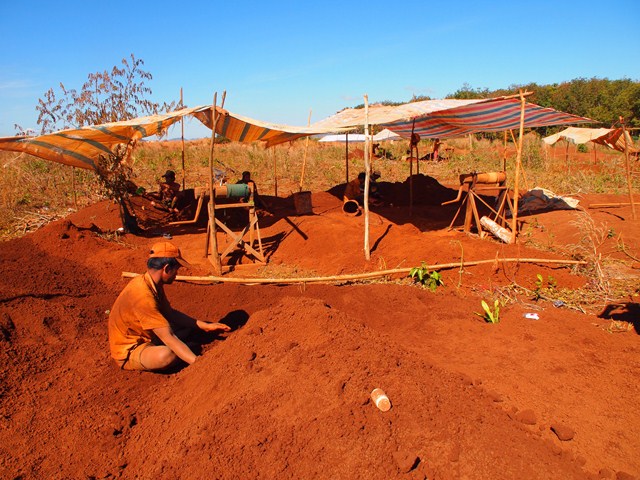មិនមានការជីកយករ៉ែក្នុងទ្រង់ទ្រាយជាលក្ខណៈឧស្សាហកម្មខ្នាតធំបានអនុវត្តនៅក្នុងប្រទេសកម្ពុជានៅឡើយទេ បើទោះបីជាអាជ្ញាប័ណ្ណរុករករ៉ែជាច្រើនត្រូវបានផ្តល់ចេញ1 និងមានក្រុមហ៊ុនរ៉ែមួយចំនួនបានរាយការណ៍ ពីការរកឃើញរ៉ែដ៏ជោគជ័យ រួមមានរ៉ែមាសជាដើមក៏ដោយ។2
នាពេលបច្ចុប្បន្ន មានក្រុមហ៊ុនមកពីប្រទេសចិន កូរ៉េ វៀតណាម អូស្ត្រាលីនិងនៅកន្លែងផ្សេងទៀត បាននឹងកំពុងរុករករ៉ែ។ ក្រុមហ៊ុនមួយចំនួនបានចាប់ដៃគូជាមួយក្រុមហ៊ុនក្នុងស្រុក យ៉ាងណាមិញ ដោយសារច្បាប់ប្រទេសកម្ពុជាអនុញ្ញាតឱ្យក្រុមហ៊ុនរ៉ែបរទេសទាំងស្រុង ទទួលបានអាជ្ញាប័ណ្ណ ក្រុមហ៊ុនមួយចំនួនធ្វើការរុករកជាលក្ខណៈឯករាជ្យ។
ការរៀបចំអណ្តូងរ៉ែ ដែលអាចជីកយករ៉ែបានមានរយៈពេលយូរនិងមានតម្លៃថ្លៃ ចំពោះអណ្តូងរ៉ែដែលមានទំហំធំត្រូវចំណាយរយៈពេលរាប់ឆ្នាំដើម្បីដំណើរការបានពេញលេញ។ ការរុករកភាគច្រើនជាការជីកយករ៉ែលោហៈ (តួយ៉ាងមាស ទង់ដែងនិងដែក) និងធ្យូងថ្ម។ នៅដើមឆ្នាំ ២០១៤ ក្រុមហ៊ុន Angkor Gold Corp បានប្រកាសថា ក្រុមហ៊ុន Mesco Gold បានដាក់ពាក្យសុំអាជ្ញាប័ណ្ណរុករករ៉ែមួយសម្រាប់គម្រោងមាស Phum Syarung។3

ការរ៉ុករកដោយដៃនៅភាគខាងកើតនៃបាងឡុង ប្រទេសកម្ពុជា។ រូបភាពថតដោយ Paul Arps នៅថ្ងៃទី ៣០ ខែ ធ្នូ ឆ្នាំ ២០១១។ ក្រោមអាជ្ញាប័ណ្ណ៖ CC BY 2.0
ក្របខ័ណ្ឌច្បាប់
រាល់ធនធានធម្មជាតិទាំងឡាយ ជាទ្រព្យសម្បត្តិរបស់រដ្ឋ ហើយការរុករកដោយគ្មានអាជ្ញាប័ណ្ណ ជាអំពើខុសច្បាប់។ ក្រោមច្បាប់រុករករ៉ែ មានអាជ្ញាប័ណ្ណរុករករ៉ែចំនួន៦ ដោយរួមមាន អាជ្ញាប័ណ្ណផ្ទេរសិទ្ធិ អាជ្ញាប័ណ្ណស្វែងរុករក និងអាជ្ញាប័ណ្ណឧស្សាហកម្មអាជីវកម្មរ៉ែ។ ប្រសិនបើក្រុមហ៊ុនមួយចង់រុករក ឬជីកយករ៉ែមានតម្លៃដូចជា មាស ទង់ដែង ដែក ឬបុកស៊ីត ក្រុមហ៊ុននោះត្រូវទទួលបានអាជ្ញាប័ណ្ណធ្វើអាជីវកម្មជាមុនសិន។ អាជ្ញាប័ណ្ណនេះ អនុញ្ញាតឱ្យមានការយកគំរូ តែមិនអនុញ្ញាតិឱ្យមានការជីកយកហួសកំណត់ទេ។ ជាទូទៅអាជ្ញាប័ណ្ណរុករករ៉ែ មានសុពលភាព២ឆ្នាំ ប៉ុន្តែអាចធ្វើការពន្យារបាន។
ប្រសិនបើសកម្មភាពរុករករ៉ែបង្ហាញថា មានបរិមាណរ៉ែច្រើនល្មមនឹងទទួលបានប្រាក់ចំណេញ ក្រុមហ៊ុនអាចសរសេរបែបបទស្នើសុំអាជ្ញាប័ណ្ណឧស្សាហកម្មអាជីវកម្មធនធានរ៉ែ។ គ្រប់សំណើរសុំអាជ្ញាប័ណ្ណឧស្សាហកម្មអាជីវកម្មធនធានរ៉ែ (ដែលចាប់ពីពេលនេះទៅហៅកាត់ថា អាជ្ញាប័ណ្ណរុករករ៉ែ) ត្រូវតែអនុម័តយល់ព្រមដោយក្រុមប្រឹក្សាអភិវឌ្ឍន៍កម្ពុជា។4 បន្ទាប់ពីទទួលបានការឯកភាពពីក្រុមប្រឹក្សាអភិវឌ្ឍន៍កម្ពុជា ក្រសួងឧស្សាហកម្ម រ៉ែ និងថាមពលនឹងចេញអាជ្ញាប័ណ្ណជូន។ អាជ្ញាប័ណ្ណអាជីវកម្មធនធានរ៉ែអាចត្រូវបានចេញជូនសម្បទានិកស្វែងរករ៉ែណាដែលមានអាជ្ញាប័ណ្ណស្វែងរករ៉ែ ហើយតំបន់សម្រាប់ស្វែងរករ៉ែត្រូវតែសិ្ថតក្នុងតំបន់តែមួយដែល អនុញ្ញាតដោយអាជ្ញាប័ណ្ណរុករករ៉ែ។ សម្បទានិកស្វែងរករ៉ែត្រូវតែដាក់ឱ្យពិនិត្យនូវការវិភាគបច្ចេកទេស ហិរញ្ញវត្ថុ បរិស្ថាន សង្គម និងសេដ្ឋកិច្ច ក្នុងគោលបំណងកំណត់ “លទ្ធភាពសេដ្ឋកិច្ចសង្គម” នៃទម្រង់ប្រតិបត្តិការជីកយករ៉ែ។5
យ៉ាងណាមិញ ការផ្លាស់ប្តូរបទបញ្ញាត្តិនៃការរុករកត្រូវបានហាមឃាត់។ មិនមានសំណើរក្នុងការបង្កើត បទបញ្ញាត្តិដែលផ្អែកលើ ច្បាប់រុករករ៉ែអូស្តា្រលីខាងលិច ដែលនឹងមកជំនួសប្រព័ន្ធកំពុងប្រើក្នុង ការចុះកុងត្រាសព្វថ្ងៃសម្រាប់ស្នើរសុំអាជ្ញាប័ណ្ណរុករករ៉ែជាមួយប្រព័ន្ធសម្បាទាន ដែលផ្តល់សិទ្ធិស្មើរគ្នា ដល់ក្រុមហ៊ុនដែលធ្វើការរុករកនៅកម្ពុជា។6
ប្រតិបត្តិការ និងលក្ខខណ្ឌសម្រាប់អ្នកកាន់កាប់អាជ្ញាប័ណ្ណ
មុនពេលអាជ្ញាប័ណ្ណរ៉ុករករ៉ែត្រូវបានផ្តល់ចេញ ការវាយតម្លៃផលប៉ះពាល់បរិស្ថានត្រូវបានធ្វើឡើងដែលរួមមាន ផែនការគ្រប់គ្រងសម្រាប់កាត់បន្ថយផលប៉ះពាល់អវិជ្ជមានទៅកាន់បរិស្ថាន និងសង្គម។ អ្នកទទួលបានអាជ្ញារប័ណ្ណ ត្រូវផ្តល់ការធានាផ្នែកហិរញ្ញវត្ថុនិងរៀបចំផែនការ សម្រាប់ការស្តារឡើងវិញបន្ទាប់ពីគម្រោងត្រូវបានបញ្ចប់។ ក្រុមហ៊ុនដែលទទួលបានអាជ្ញាប័ណ្ណត្រូវការពារសុខភាពរបស់កម្មករនិយោជិត និងសាធារណជន ដ៏ដូចជាអប់រំ បណ្តុះបណ្តាល និងផ្តល់ការងារដល់ប្រជាពលរដ្ឋកម្ពុជា។7
អ្នកកាន់កាប់អាជ្ញាប័ណ្ណតម្រូវឱ្យបង់ថ្លៃចុះបញ្ជី ថ្លៃបន្តអាណាត្តិ ឬផ្ទេរសិទ្ធិអាជ្ញាប័ណ្ណ និងថ្លៃឈ្នួលដីធ្លី។ ប្រាក់កម្រៃមួយចំនួនដែលបានមកពីការរុករករ៉ែត្រូវបង់ជូនរដ្ឋ ដែលអត្រានៃការបង់អាស្រ័យ ទៅលើប្រភេទនៃរ៉ែរុករក។ អ្នកកាន់កាប់អាជ្ញាប័ណ្ណមានកាតព្វកិច្ចក្នុងការបង់ពន្ធដារតម្រូវផងដែរ។
តើការរុករករ៉ែចាំបាច់ធ្វើឡើងនៅទីណាខ្លះ ?
ការរុករករ៉ែអាចធ្វើឡើងលើដីឯកជនដោយមានការអនុញ្ញាតជាលាយលក្ខណ៍អក្សរពីសំណាក់ម្ចាស់ដី។
ច្បាប់ស្តីពីការរុករករ៉ែបានចែងថា ការរុករករ៉ែទាំងអស់នៅក្នុង “តំបន់រមណីយដ្ឋានវប្បធម៌ប្រវត្តិសាស្ត្រនិងបេតិកភ័ណ្ឌជាតិ” ត្រូវបានហាមឃាត់ហើយសកម្មភាពរុករករ៉ែនៅក្នុងតំបន់ “ការពារ បម្រុងទុកឬតំបន់ហាមឃាត់” អាចធ្វើទៅបានដោយមានការអនុញ្ញាតជាលាយលក្ខណ៍អក្សរពីសំណាក់អាជ្ញាធរ ទទួលបន្ទុក។8 ច្បាប់រុក្ខប្រមាញ់ឆ្នាំ២០០២ អនុញ្ញាតឱ្យមានការជីកយករ៉ែក្នុងតំបន់សម្បត្តិ ព្រៃឈើអចិន្ត្រៃយ៍។យ៉ាងណាមិញ រាល់សកម្មភាពនៃការជីកយករ៉ែដែលបានស្នើឡើងត្រូវតែជាបាន ឆ្លងកាត់ “ការសិក្សាវាយតម្លៃជាមុន” ដោយក្រសួងកសិកម្មរុក្ខាប្រមាញ់និងនេសាទ (MAFF)។9
នីត្យានុកូលភាពនៃប្រតិបត្តិការរុករករ៉ែនៅលើដីដែលគ្រប់គ្រងដោយ ជនជាតិដើមភាគតិចទាមទារឱ្យមានការបំភ្លឺ។ ភាគច្រើននៃការរុករករ៉ែនាពេលបច្ចុប្បន្ននេះត្រូវបានធ្វើឡើងនៅ ក្នុងតំបន់ដែលមានប្រជាជនជាជនជាតិដើមភាគតិចច្រើន។ ច្បាប់ភូមិបាល ឆ្នាំ២០០១បានចែងថា សហគមន៍ជនជាតិដើមភាគតិចមានសិទ្ធិចុះបញ្ជីសហកម្មសិទ្ធិលើ “ដីទាំងអស់ដែលសហគមន៍បានរៀបចំធ្វើនិវេសនដ្ឋាន និងប្រកបរបរកសិកម្ម តាមប្រពៃណី”។10 រហូតមកទល់ពេលសដែលសហគមន៍មានឱកាស ដើម្បីចុះឈ្មោះដីរបស់ពួកគេ ការការពារបណ្តោះអាសន្នត្រូវបានផ្តល់ឱ្យដោយច្បាប់ភូមិបាលឆ្នាំ ២០០១ ដែលបានចែងថា ក្រុមជនជាតិដើមភាគតិចដែលមានស្រាប់នៅពេលដែលច្បាប់នេះត្រូវបានអនុម័ត “នេះនឹងបន្តគ្រប់គ្រងសហគមន៍និងអចលនវត្ថុរបស់ខ្លួនតាមប្រពៃណីរបស់ខ្លួន” រហូតទាល់តែ ពួកគេអាចចុះឈ្មោះរបស់ពួកគេ។11 ដូច្នេះរុករករ៉ែលើដីរបស់ជនជាតិដើមភាគតិច គឺជាអំពើល្មើសនឹងច្បាប់ភូមិបាល។
និន្នាការថ្មី
ក្រុមហ៊ុនបរទេសជាច្រើន បានរាយការណ៍ពីរបកគំហើញវិជ្ជមាន ជាពិសេសរ៉ែមាស។12 ធនធានធម្មជាតិ ភាគច្រើនរបស់ប្រទេសកម្ពុជាស្ថិតនៅក្នុងភូមិភាគឦសាននៃប្រទេសស្ថិត នៅខេត្តមណ្ឌលគិរី ខេត្តរតនគិរីនិងខេត្តក្រចេះ។ ទីនេះក៏ជាជម្រកនៃប្រព័ន្ធអេកូឡូស៊ីសម្បូរបែបចម្រុះផងដែរ។ យោងតាមរបាយការណ៍របស់អង្គការមិនមែនរដ្ឋាភិបាលមួយក្នុងឆ្នាំ ២០០៩ “ខេត្តមណ្ឌលគិរីមានតំបន់ជម្រកសត្វព្រៃចំនួនបួននិង តំបន់ព្រៃការពារពីរកន្លែងដែលមានផ្ទៃដីសរុបចំនួន១ ២៦៧ ៣២២ ហិកតា។ កាលពីឆ្នាំ ២០០៩ ផ្ទៃដីមិនតិចជាង ២៨២ ៧០០ ហិកតាឬ ២២ ភាគរយនៃតំបន់ការពារទាំងនេះដែលត្រូវបានគ្របដណ្តប់ដោយសម្បទានរ៉ែ “។13
ក្នុងឆ្នាំ២០១១ អណ្តូងរ៉ែទីតានញ៉ូមក្នុងខេត្តកោះកុង ត្រូវបានលុបចោលដោយសារតែ “សេចក្តីព្រួយបារម្ភពីផលប៉ះពាល់ទៅលើបរិស្ថានជីវចម្រុះ និងជីវភាពរស់នៅក្នុងមូលដ្ឋាន” ដែលមនុស្សជាច្រើនយលឃើញថាជាសញ្ញាណ លើកទឹកចិត្តមួយដែលបង្ហាញថារដ្ឋាភិបាលបានយល់ដឹងពីតម្រូវការ តុល្យភាពរវាងផលប៉ះពាល់នៃការអភិវឌ្ឍ និងអត្ថប្រយោជន៍ដែលផ្តល់ឱ្យ។14
យ៉ាងណាមិញ សហគមន៍មួយចំនួនមិនអាចដឹងឡើយថាមានអាជ្ញាប័ណ្ណផ្តល់ចេញក្នុង តំបន់របស់ពួកគេទេ រហូតដល់ពេលដែលពួកគេមើលឃើញបុគ្គលិកក្រុមហ៊ុន ធ្វើការសាកល្បងនៅនឹងកន្លែង ឬឃើញមានការិយាល័យរបស់ក្រុមហ៊ុនបង្កើតឡើង។ច្បាប់ស្តីពីការរុករករ៉ែ បានផ្តល់ព័ត៌មានពាក់ព័ន្ធនឹងការរុករករ៉ែដែលបានចែងថា “រាល់លិខិតស្នើសុំ របាយការណ៍ ផែនការនិងលិខិតជូនដំណឹង” គឺជាការសម្ងាត់រហូតដល់អាជ្ញាប័ណ្ណត្រូវបានបញ្ចប់ និងលុះត្រាតែម្ចាស់អាជ្ញាប័ណ្ណអនុញ្ញាត្តិការបង្ហាញនេះ។ ព័ត៌មានដែលទាក់ទងនឹងបញ្ហាបរិស្ថាន និងសង្គមអាចនឹងត្រូវចេញផ្សាយជាសាធារណៈដោយឆ្លងកាត់ការសម្រេចចិត្តរបស់រដ្ឋមន្ត្រីទទួលបន្ទុក ក្នុងក្រសួងរ៉ែ និងថាមពល។15 នេះគឺជាចំនុចរាំងស្ទះសម្រាប់ជនដែលមានបំណងធ្វើការត្រួតពិនិត្យឬ ស៊ើបអង្កេតការអនុលោមតាមច្បាប់របស់អាជីវកម្មរ៉ែ ។
កង្វះខាតតម្លាភាព គឺជាសេចក្តីព្រួយបារម្ភមួយសម្រាប់ក្រុមហ៊ុនដែលមានបំណង ធ្វើការវិនិយោគក្នុងវិស័យរ៉ែ ដោយសារពួកគេមិនអាចមានលទ្ធភាពក្នុងការអះអាងអំពីព្រំដែននៃដីសម្បទានដែលមានស្រាប់ ឬព្រំដែនដែលបានចែងក្នុងអាជ្ញាប័ណ្ណ។ កន្លងមក ក៏ធ្លាប់មានសេចក្តីរាយការណ៍អំពីអាជ្ញាបណ្ណរ៉ែលើតំបន់ត្រួតស៊ីគ្នា និងដីសម្បទានសេដ្ឋកិច្ចត្រួតស៊ីគ្នាផងដែរ។ ជាចុងក្រោយ រាល់ការត្រួតពិនិត្យគ្រប់ប្រភេទមានផលលំបាកប្រសិនបើមានកង្វះខាត ក្របខ័ណ្ឌនៃការធ្វើនិយ័តកម្មជាសាធារណៈសម្រាប់ការផ្តល់ អាជ្ញាប័ណ្ណរុករករ៉ែសមស្រប។
ធ្វើបច្ចុប្បន្នភាពនៅថ្ងៃទី២៦ ខែតុលា ឆ្នាំ២០១៥
ទាក់ទងនឹងការរុករករ៉ែតាមបែបឧស្សាហកម្ម
ឯកសារយោង
- 1. ក្រសួងឧស្សាហកម្មរ៉ែ និងថាមពល, ឆ្នាំ២០១៣, “ស្ថានភាពបច្ចុប្បន្ននៃឧស្សាហកម្មរ៉ែនៅកម្ពុជា”. ចុះថ្ងៃទី៦ ខែមីនា ឆ្នាំ២០១៣។
- 2. Asia Miner News, ឆ្នាំ២០១៤. ចុះថ្ងៃទី ២២ ខែមករា ឆ្នាំ២០១៤។
- 3. ដូចឯកសារខាងដើម។
- 4. អនុក្រឹត្យលេខ ០៨ ស្តីពីការកំណត់គោលការណ៍វិនិយោគសម្រាប់រាល់ធនធានរ៉ែទាំងអស់ (កែប្រែដោយអនុក្រឹត្យលេខ ១១៣) ឆ្នាំ២០០៥ មាត្រា១។
- 5. ច្បាប់ស្តីពីការគ្រប់គ្រង និងការរុករកធនធានរ៉ែ ឆ្នាំ២០០១, មាត្រាទី១១(៦)។
- 6. Angkor Gold, ២០១៥. ចូលមើលថ្ងៃទី២៥ ខែតុលា ឆ្នាំ២០១៥ http://angkorgold.ca/wp-content/uploads/2015/08/121-Group-Presentation.pdf
- 7. ច្បាប់ស្តីពីការគ្រប់គ្រង និងការរុករកធនធានរ៉ែ ឆ្នាំ២០០១, មាត្រាទី ២១; អាចរកបានក្នុងអនុក្រឹតលេខ ៧២ ស្តីពីដំណើរការនៃប៉ះពាល់បរិស្ថាន ឆ្នាំ១៩៩៩, មាត្រាទី ២។
- 8. ច្បាប់ស្តីពីការគ្រប់គ្រង និងការរុករកធនធានរ៉ែ ឆ្នាំ២០០១, មាត្រាទី ៧ និង ៨។
- 9. ច្បាប់ស្តីពីការគ្រប់គ្រងព្រៃឈើ ឆ្នាំ២០០២, មាត្រាទី ៣៥។
- 10. ច្បាប់ស្តីពីការគ្រប់គ្រង និងការរុករកធនធានរ៉ែ ឆ្នាំ២០០១, មាត្រាទី២៥។
- 11. ច្បាប់ស្តីពីការគ្រប់គ្រង និងការរុករកធនធានរ៉ែ ឆ្នាំ២០០១, មាត្រាទី២៣។
- 12. Marketwatch, ឆ្នាំ២០១៥។ ចូលមើលថ្ងៃទី២៥ ខែតុលា ឆ្នាំ២០១៥។ http://www.marketwatch.com/story/angkor-gold-announces-next-step-forward-for-cambodias-first-commercial-gold-mine-2014-12-03/
- 13. “ព្រៃឈើ, ដំណាំ និងសម្បទាន” នៅក្នុងឯកសារអង្គការក្រៅរដ្ឋាភិបាលស្តីពីទីតាំងការអភិវឌ្ឍន៍កម្ពុជានៅឆ្នាំ ២០០៧-២០០៨, “ការត្រួតពិនិត្យការអនុវត្តន៍នៃឆ្នាំ២០០៧ លើសូចនាករតាមដានការ CDCF រួម និងផែនការយុទ្ធសាស្ត្រអភិវឌ្ឍន៍ជាតិ ២០០៦-២០១០”, រាជធានីភ្នំពេញ, ខែវិច្ឆិកា ឆ្នាំ២០០៨។
- 14. Jeremy Hance, “នាយករដ្ឋមន្រ្តីកម្ពុជាបានលុបចោលគម្រោងរ៉ែទីតាញ៉ូដោយបានលើកឡើងពីផលប៉ះពាល់លើជីវចំរុះ និងប្រជាជនក្នុងមូលដ្ឋាន”, ចូលអានថ្ងៃទី១១ ខែមេសា ឆ្នាំ២០១១។ http://news.mongabay.com/2011/0410-hance_titanium_cambodia.html
- 15. ច្បាប់ស្តីពីការគ្រប់គ្រង និងការរុករកធនធានរ៉ែ ឆ្នាំ២០០១, មាត្រាទី ២០។

